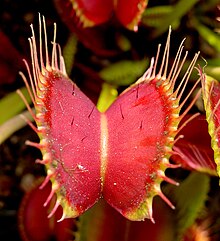
Back Dionaea muscipula AN خناق الذباب Arabic خناق الذباب ARZ Milçəkqapan Azerbaijani میلچک قاپان AZB Венерина мухоловка Bulgarian বুনো কীটকল (উদ্ভিদ) Bengali/Bangla Dionea Catalan Dionaea muscipula CEB ᏳᏈᎳ CHR
| Venus flytrap | |
|---|---|

| |
| Leaf | |
| Scientific classification | |
| Kingdom: | Plantae |
| Clade: | Tracheophytes |
| Clade: | Angiosperms |
| Clade: | Eudicots |
| Order: | Caryophyllales |
| Family: | Droseraceae |
| Genus: | Dionaea Sol. ex J.Ellis 1768 |
| Species: | D. muscipula
|
| Binomial name | |
| Dionaea muscipula J.Ellis
| |

| |
| Distribution | |
| Synonyms[3] | |
| |
The Venus flytrap (Dionaea muscipula) is a carnivorous plant native to the temperate and subtropical wetlands of North Carolina and South Carolina, on the East Coast of the United States.[4] Although various modern hybrids have been created in cultivation, D. muscipula is the only species of the monotypic genus Dionaea. It is closely related to the waterwheel plant (Aldrovanda vesiculosa) and the cosmopolitan sundews (Drosera), all of which belong to the family Droseraceae.[5] Dionaea catches its prey—chiefly insects and arachnids—with a "jaw"-like clamping structure, which is formed by the terminal portion of each of the plant's leaves; when an insect makes contact with the open leaves, vibrations from the prey's movements ultimately trigger the "jaws" to shut via tiny hairs (called "trigger hairs" or "sensitive hairs") on their inner surfaces. Additionally, when an insect or spider touches one of these hairs, the trap prepares to close, only fully enclosing the prey if a second hair is contacted within (approximately) twenty seconds of the first contact. Triggers may occur as quickly as 1⁄10 of a second from initial contact.[6]
The requirement of repeated, seemingly redundant triggering in this mechanism serves as a safeguard against energy loss and to avoid trapping objects with no nutritional value; the plant will only begin digestion after five more stimuli are activated, ensuring that it has caught a live prey animal worthy of consumption. These hairs also possess a heat sensor. A forest fire, for example, causes them to snap shut, making the plant more resilient to periods of summer fires.[7]
Although widely cultivated for sale, the population of the Venus flytrap has been rapidly declining in its native range.[8] As of 2017, the species was under Endangered Species Act review by the U.S. Fish & Wildlife Service.[9]
- ^ Schnell, D.; Catling, P.; Folkerts, G.; Frost, C.; Gardner, R.; et al. (2000). "Dionaea muscipula". IUCN Red List of Threatened Species. 2000: e.T39636A10253384. doi:10.2305/IUCN.UK.2000.RLTS.T39636A10253384.en. Retrieved 19 November 2021.
- ^ "Appendices". CITES. Retrieved 14 January 2022.
- ^ Schlauer, J. (N.d.) Dionaea muscipula Archived 24 July 2020 at the Wayback Machine. Carnivorous Plant Database.
- ^ "Dionaea muscipula J.Ellis". Plants of the World Online. Royal Botanic Gardens, Kew. 2023. Retrieved 30 October 2023.
- ^ Ellison, Aaron M.; Adamec, Lubomír, eds. (2018). "4:Systematics and evolution of Droseraceae". Carnivorous plants: physiology, ecology, and evolution (1st ed.). Oxford, England, UK: Oxford University Press. p. 45. ISBN 9780198779841.
- ^ Sumner, Thomas (20 November 2012). "Investigating the Venus Flytrap". insidescience.com. Retrieved 18 March 2018.
- ^ doi: https://doi.org/10.1038/d41586-023-02654-x
- ^ Cite error: The named reference
:0was invoked but never defined (see the help page). - ^ "Venus Flytrap: Under Endangered Species Act review" (PDF). U.S. Fish & Wildlife Service. June 2017. Archived from the original (PDF) on 6 October 2019. Retrieved 15 December 2019.
Cite error: There are <ref group=note> tags on this page, but the references will not show without a {{reflist|group=note}} template (see the help page).
